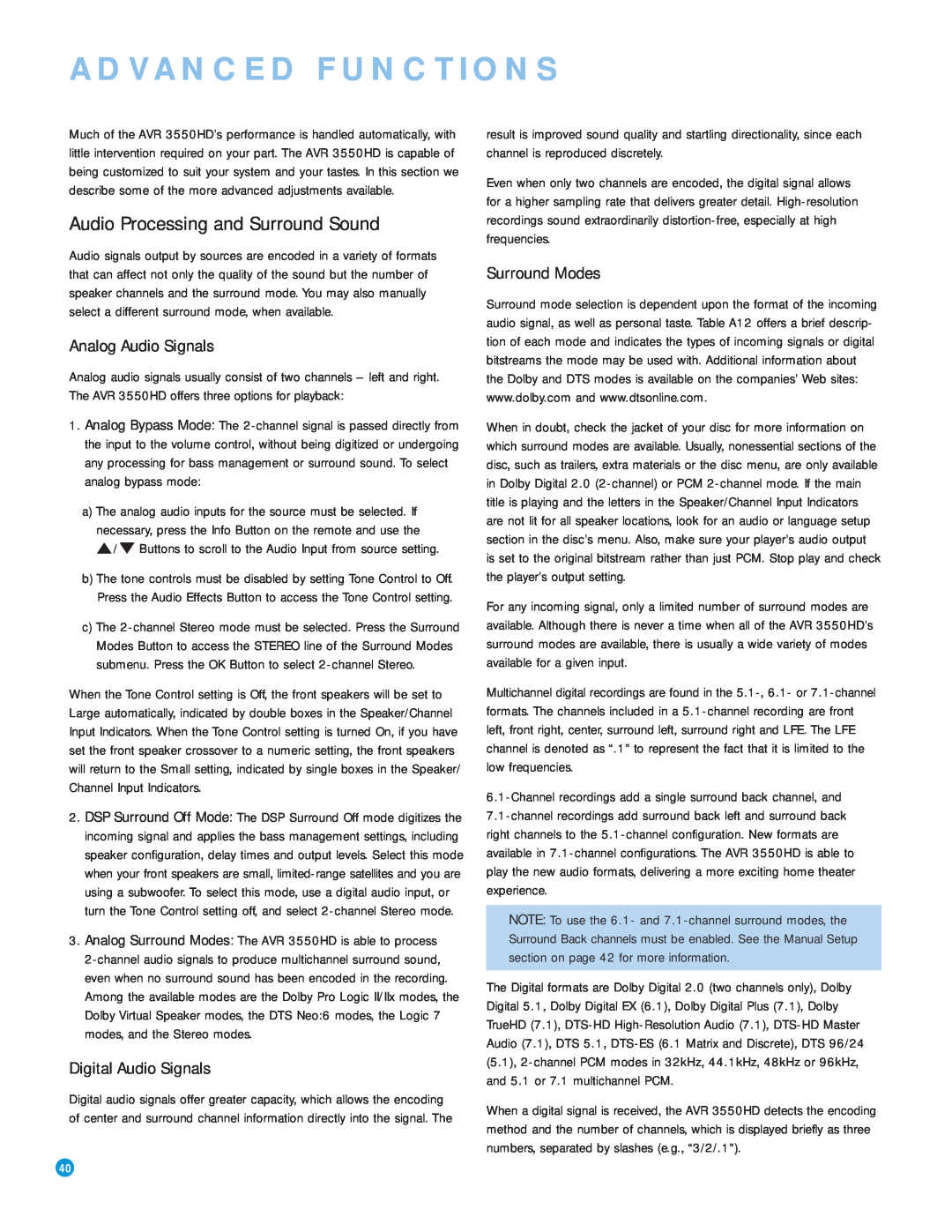
ADVANCED FUNCTIONS
Much of the AVR 3550HD’s performance is handled automatically, with little intervention required on your part. The AVR 3550HD is capable of being customized to suit your system and your tastes. In this section we describe some of the more advanced adjustments available.
Audio Processing and Surround Sound
Audio signals output by sources are encoded in a variety of formats that can affect not only the quality of the sound but the number of speaker channels and the surround mode. You may also manually select a different surround mode, when available.
Analog Audio Signals
Analog audio signals usually consist of two channels – left and right. The AVR 3550HD offers three options for playback:
1.Analog Bypass Mode: The
a)The analog audio inputs for the source must be selected. If necessary, press the Info Button on the remote and use the ⁄ /¤ Buttons to scroll to the Audio Input from source setting.
b)The tone controls must be disabled by setting Tone Control to Off. Press the Audio Effects Button to access the Tone Control setting.
c)The
When the Tone Control setting is Off, the front speakers will be set to Large automatically, indicated by double boxes in the Speaker/Channel Input Indicators. When the Tone Control setting is turned On, if you have set the front speaker crossover to a numeric setting, the front speakers will return to the Small setting, indicated by single boxes in the Speaker/ Channel Input Indicators.
2.DSP Surround Off Mode: The DSP Surround Off mode digitizes the incoming signal and applies the bass management settings, including speaker configuration, delay times and output levels. Select this mode when your front speakers are small,
3.Analog Surround Modes: The AVR 3550HD is able to process
Digital Audio Signals
Digital audio signals offer greater capacity, which allows the encoding of center and surround channel information directly into the signal. The
result is improved sound quality and startling directionality, since each channel is reproduced discretely.
Even when only two channels are encoded, the digital signal allows for a higher sampling rate that delivers greater detail.
Surround Modes
Surround mode selection is dependent upon the format of the incoming audio signal, as well as personal taste. Table A12 offers a brief descrip- tion of each mode and indicates the types of incoming signals or digital bitstreams the mode may be used with. Additional information about the Dolby and DTS modes is available on the companies’ Web sites: www.dolby.com and www.dtsonline.com.
When in doubt, check the jacket of your disc for more information on which surround modes are available. Usually, nonessential sections of the disc, such as trailers, extra materials or the disc menu, are only available in Dolby Digital 2.0
For any incoming signal, only a limited number of surround modes are available. Although there is never a time when all of the AVR 3550HD’s surround modes are available, there is usually a wide variety of modes available for a given input.
Multichannel digital recordings are found in the
NOTE: To use the 6.1- and
The Digital formats are Dolby Digital 2.0 (two channels only), Dolby Digital 5.1, Dolby Digital EX (6.1), Dolby Digital Plus (7.1), Dolby TrueHD (7.1),
When a digital signal is received, the AVR 3550HD detects the encoding method and the number of channels, which is displayed briefly as three numbers, separated by slashes (e.g., “3/2/.1”).
40 | 40 |
